Haft-sin
Haftsin (Persian: هفتسین) is an arrangement of seven symbolic items whose names start with the letter "س" (pronounced as "seen"), the 15th letter in the Persian alphabet; "haft" (هفت) is Persian for "seven".[1][2] It is traditionally displayed at Nowruz, the Iranian New Year, which is celebrated on the day of the vernal equinox, marking the beginning of spring in the Northern Hemisphere.

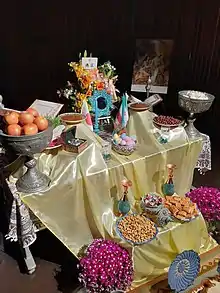
Items of Haft-seen

The following are the primary items of Haft-seen, whose Persian names begin with the letter S in the Persian alphabet.[1][2]
- Sabzeh (سبزه) – wheat, barley, mung bean, or lentil sprouts grown in a dish.
- Samanu (سمنو) – wheat germ sweet pudding.
- Senjed (سنجد) – oleaster.
- Serkeh (سرکه) – vinegar.
- Seeb (سیب) – apple.
- Seer (سیر) – garlic.
- Somagh (سماق) – sumac.
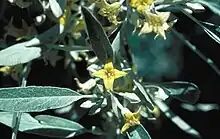
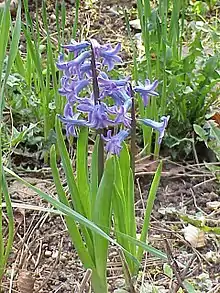
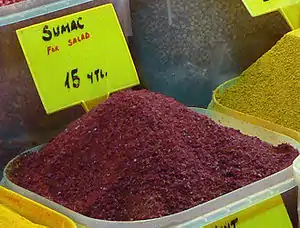
Coins (سکه sekke), hyacinth (سنبل sombol), and clock (ساعت suat also pronounced so-at) are sometimes included too. Other symbolic items that are typically used to accompany Haft-sin include a mirror, candles, painted eggs, goldfish, and traditional Persian confections.
A "book of wisdom" is also commonly included, which might be , Avesta, the Shahnameh, or, most commonly, the Quran and the Divān of Hafez.[1]
Symbolic Roots of Haft-seen
The Haft-Seen table is composed of “haft” (or seven) essential symbols that represent nature, and “sin” which may have been shortened from “sini” (or trays), which held these essential symbols. The symbols break down into three from the material world (or “donyaheh mahdoodiat”), three from the immaterial world (or “donayeh maanah”) — this is the world of meaning and ideas — and one symbol that sits between and ties these two worlds together. By tradition, Iranian families take great pains to create the most beautiful Haft-Seen table that they can, for not only does it embody values both traditional and spiritual, it is also appreciated by the visitors during Nowruz visiting exchanges as a reflection of the families' aesthetic sense and good taste.
Items that start with Persian letter "س":
- Sabzeh (سبزه): Sprouting /Grass: the symbol of rebirth and growth.
- Samanu (سمنو): the symbol of power and strength.
- Senjed (سنجد): the symbol of love.
- Somāq (سماق): Sumac: the symbol of sunrise.
- Serkeh (سرکه): Vinegar: the symbol of patience.
- Seeb (سیب): Apple: the symbol of beauty.
- Seer (سیر): Garlic: the symbol of health and medicine.
Other items that start with Persian letter "س" that are sometimes included:
- Sonbol (سنبل): Hyacinth: the symbol of spring's arrival.
- Sekkeh (سکه): Coin: the symbol of matter, material world, wealth and prosperity.
- Saat (ساعت): Clock: the symbol of time.
Items that don't start with "س" but, nonetheless, are invariably included:
- Tokhm-e Morg Rangi (تخممرغ رنگی): Eggs: the symbol of fertility.
- Ayina (آینه): Mirror: the symbol of self-reflection.
- Shem'a (شمع): Candle: the symbol of enlightenment.
- Maahi-ye Qırmız (ماهی قرمز): Goldfish: the symbol of progress.
- Ketaab (کتاب): Book: the symbol of wisdom.
Afghan Haft Mewa
In Afghanistan, people prepare Haft Mēwa (Persian: هفتمیوه) (literally translates as Seven Fruits) in addition to or instead of Haft Seen which is common in Iran. Haft Mewa is like a fruit salad made from seven different dried fruits, served in their own syrup. The seven dried fruits are: raisins, Senjed (the dried fruit of the oleaster tree), pistachios, hazelnuts, prunes (dried apricots), walnuts and either almonds or another species of plum fruit.[3][4]
Gallery
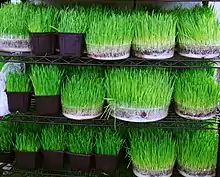 Wheatgrass, one of the items of Haft-sin.
Wheatgrass, one of the items of Haft-sin.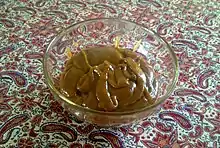 A bowl of samanu, one of the items of Haft-sin.
A bowl of samanu, one of the items of Haft-sin..jpg.webp) Goldfish, one of the items of Haft-sin.
Goldfish, one of the items of Haft-sin.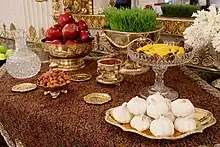 A Haft-sin table at the White House.
A Haft-sin table at the White House. A Haft-sin table at a hotel in Bijar, Kurdistan.
A Haft-sin table at a hotel in Bijar, Kurdistan. A Haft-sin table at Sharif University of Technology.
A Haft-sin table at Sharif University of Technology. A Haft-sin table.
A Haft-sin table. A Haft-sin table.
A Haft-sin table.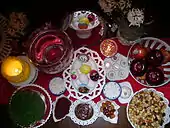 A Haft-sin table.
A Haft-sin table. A Haft-sin table.
A Haft-sin table. A Haft-sin table.
A Haft-sin table. Haft Mewa
Haft Mewa A Haft-sin table.
A Haft-sin table.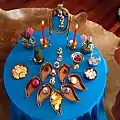 A Haft-sin table.
A Haft-sin table. A Haft-sin table.
A Haft-sin table. Haft Mewa
Haft Mewa
See also
- Passover Seder plate, an aesthetically similar (except for its element of animal sacrifice, a practice strictly banned by Zoroastrians) display for the Jewish holiday of Passover; and the Seven food Species from Deuteronomy 8:8 that Jews traditionally eat on Tu Bishvat (the Jewish "New Year for Trees", roughly January/February), Sukkot (the "Festival of Booths" - harvest/autumn), and Shavuot (the "Festival of Weeks", roughly seven weeks after the start of Passover).
- Twelve-dish Christmas Eve supper
References
- Campo, Juan Eduardo (2009). "Nawruz". Encyclopedia of Islam. Infobase Publishing. pp. 524–525. Archived from the original on 2017-10-14. Retrieved 2018-04-17.
- "Noruz, manifestation of culture of peace, friendship among societies". Tehran Times. April 7, 2018. Archived from the original on April 18, 2018. Retrieved April 17, 2018.
- Sethi, Simran (2022-03-21). "Nowruz is banned in Afghanistan, but families continue to celebrate". NPR. Archived from the original on 2022-04-28. Retrieved 2022-04-29.
- Deravian, Naz (2022-03-14). "For Afghans Abroad, Nowruz Is a Chance to Reflect". The New York Times. ISSN 0362-4331. Archived from the original on 2022-04-29. Retrieved 2022-04-29.
External links
- Shahbazi, A. Shapur (March 1, 2012). "HAFT SIN". Encyclopaedia Iranica. Vol. XI. pp. 524–526.